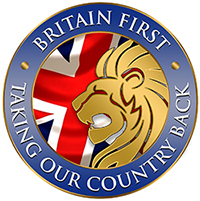 Monday - August 03, 2009
Monday - August 03, 2009
First shots of combat photography in new exhibition of Crimean War !!!!!!!!!!!!
How I wish I could get to London for the exhibition. Be like 7th heaven to me. Crave this sort of thing and never get enough.
We have a newspaper in town that has published without interruption since 1772. I love their archives of old woodcuts and especially when photography came into use. Hey .. the paper today printed a tiny snapshot of a man who lived to 107, his name was Conrad Heyer, (1749-1856) and he crossed the Delaware with Washington. DAMN! I never knew the name of one person who was with Washington. Let alone see a photo of that person in later years.
That’s so unbelievable tho. 107? No health and safety or info on cholesterol and fatty food and smoking etc. Though mainly I know they died pretty young back then.
The Telegraph didn’t publish on line the other two photos. Not as large or dramatic as this one so maybe it doesn’t matter.
The first shots of war ever captured by photographers are to appear in a new exhibition.
By Richard Edwards
Published: 7:00AM BST 03 Aug 2009
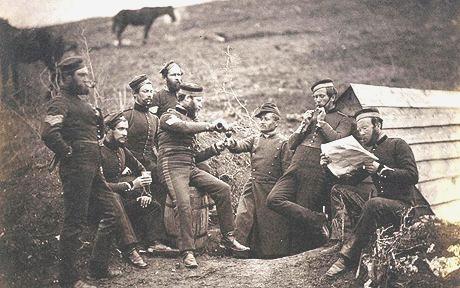
Entente Cordiale?, 1855 Photo: Roger Fenton
The pictures are taken from the Crimean War (1848-1856) and the Second Sikh War (1848) by four pioneers of photography, including Roger Fenton.
He was sent to the Crimea by Prince Albert in an attempt to alter public opposition to the war and was told before he departed for the frontline: “No dead bodies.”
His pictures were taken on glass plates and processed and printed in a converted wine merchant’s horse-drawn wagon. One picture of troops posing shows a group of British and French soldiers enjoying a drink and a smoke in an image called “L’Entente Cordiale”.
He was unable to photograph the infamous Charge of the Light Brigade, but documented the cannonball-strewn aftermath of the Valley of Death in 1855.
The work of James Robertson and Felice Beato is also going on show from the Crimean War.
Fought between the Russian Empire and an alliance of troops from Britain, France and the Ottoman Empire, it is considered the first “modern” conflict in terms of tactics, weaponry, communications and propaganda.
The earliest images on display are taken by Josh McCosh in 1848 during the war between the Sikh Empire and the British Empire in the Punjab.
The National Army Museum will be showcasing the work in the exhibition First Shots: Early War Photography 1848–1860 at the White Space Gallery in Chelsea, west London, next month
A spokesman said: “First Shots will document war photography in its infancy. Using some of the earliest photos in the museum’s collection it will explore what drove its pioneers, the technical, social and environmental pressures which shaped their work and the impact which the images they produced had upon culture and society”.
If nobody minds too much, as long as I’m banging on about olde photos and a bit of history, here’s a photo of my wife’s great,great uncle. He died seving in India at the age of 27, in 1911.
He was William Edward Gammon
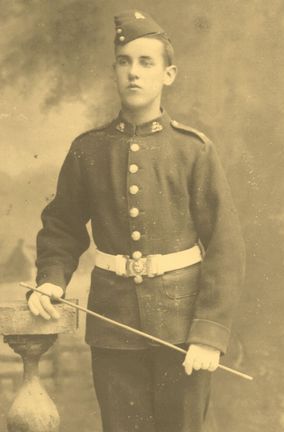
Posted by peiper
Filed Under: • Art-Photography • History • UK • War-Stories •
• Comments (3)
 Tuesday - July 14, 2009
Tuesday - July 14, 2009
JOURNAL OF ONE OF MANY VERY BRAVE BATTLING BRITS IN HARMS WAY. THIS ONE DIDN’T MAKE IT.
Greeting us on the front page of the morning Telegraph was an almost full page photo of Lt. Evison, along with a journal he was keeping.
I feel very bad for the casualties they are taking. True, Americans may have lost more but then we have a larger population to draw on. Doesn’t lessen the loss most of us feel for all of them. They are ALL TOO YOUNG.
One of the pressing issues over here and it is approaching a scandalous level, is the charge (supported by the late Lt. Evison here) that Brit troops are NOT being given the proper military support in weapons and armour. In fact, an article only yesterday suggests that British troops have been given vehicles that have already been REJECTED by the US Military as not up to the task.
The suggestion btw, that Brit troops are given short shrift when it comes to equipment is not a new one.
I have been reading that for at least a year. Returning veterans have spoken with awe in regard to what Americans have to fight with, and have begged for same.
It is further charged that the British Prime Minister, Gordon Brown, has made cuts in the military budget that have brought this sorry state of affairs about.
I’m not close enough to that to know if it’s true or political rhetoric by his opposition. But the papers do report a budget cut for the army so I would imagine it is true. Which I personally think put the blood of fallen Brits all over the hands of those responsible.
Obviously I have not posted the journal here in full. I have just taken cuts from it.
I urge my fellow Americans to take a minute to read it. In fact I urge everyone to do so.
Lieutenant Mark Evison, who died in May from wounds received in Afghanistan, kept a remarkable journal - published here for the first time - about the harsh realities of fighting in Helmand.
21 April
I have been trying to work out exactly what is and what is not here. This is harder than it seems. Paperwork trails which tend to disappear are commonplace. As it stands I have a lack of radios, water, food and medical equipment. This with manpower is what these missions lack. It is disgraceful to send a platoon into a very dangerous area with two weeks’ water and food and one team medics pack. Injuries will be sustained which I will not be able to treat and deaths could occur which could have been stopped. We are walking on a tightrope and from what it seems here are likely to fall unless drastic measures are undertaken.
The ANA are an interesting bunch. They earn $200 a month, compared to what they could do if they farmed poppies, $4,000 a month. Many of them fight for blood feuds with the Taliban who have killed family members. All they want to do is kill Taliban and it will be interesting how they deal with being contacted on the ground. Currently they seem rather blasé. They will happily leave the PB [patrol base] without helmet or body armour. They came with various weapon types – Ak 47s [assault rifles], M 16s [rifles], etc as well as what looks like a couple of bagfuls of RPGs [rocket propelled grenades] – could be interesting.
The first casualty. Yesterday morning at 10.48 Sgt Fasfous an MFC [mortar fire controller] was on patrol with an OMLT [operational mentor and liaison team] in a joint patrol with an ANA [Afghanistan National Army] North of Gereskh. The call sign was contacted and unfortunately he was killed instantly as well as one interpreter. A captain in the Light Dragoons was seriously injured and extracted by MIRT [medical instant response team] to Bastion.
Life is fragile and out here it feels like it can be removed in an instant. It almost makes life even more valuable and shows the fragility that many in the West I believe do not understand.There were now just 7 bods plus myself stuck on the wrong side of the canal. We had to make the decision just to go for it. With a rapid fire from the Platoon we sprinted down the bank, through the canal, back up the friendly bank and then tried to push back into the PB. More luck than anything else saw the platoon safely back behind sturdy walls, laughing at the contact we had just been in. For me it is still the fear of making a wrong decision which sits heavily on my mind. I am responsible for every person within this PB and I fear that we will not always be as lucky as we were today. At least today I proved to myself that I will not freeze the next time I get shot at. I do not expect this to be in the distant future.
The flies are uncontrollable. As I write this there are approximately 10 crawling over my legs and an unknown amount swarming over my head. Amazingly once they have disappeared in the early evening they are replaced by another of life’s annoying creatures, the mosquito. They seem to be able to infiltrate any clothing and get into mosquito nets like effective bank robbers. They then spend the next few hours eating their hearts out much to the annoyance of the body lying below.
(Mark was fatally wounded by a single bullet in his shoulder during an early patrol and ambush on 9 May. He commanded his men back to safety, and lost consciousness from bleeding within an hour. He never regained consciousness).
© Margaret Evison 2009
Posted by peiper
Filed Under: • Heroes • UK • War-Stories •
• Comments (3)
 Friday - July 10, 2009
Friday - July 10, 2009
PAST HEROS ….. WARRIORS BOTH. ONE BRIT … ONE AUSSIE … RIP
I don’t do these every day or even every week. I suppose I could do one every day as those old soldiers fade away.
I think they belong in the blog world and as far as I am aware, nobody else is doing it. They belong to a past generation who have made today possible.
And so I honor them as I can.
This was not a ‘politically correct’ generation. They can not have been happy to see the mess following generations have made of the world they helped to save.
RIP
Major Roy Vallance, who has died aged 86, commanded a tank in every battle from Normandy to the Baltic and won a Distinguished Conduct Medal.
Published: 6:50PM BST 09 Jul 2009
In the last days of the campaign in Germany, Vallance, then a sergeant serving with the 2nd Fife and Forfar Yeomanry, Royal Armoured Corps (2 F&FY), was patrolling the banks of the River Elbe, north of Winsen, when his troop was attacked by a bazooka patrol of 20 SS.
It was first light and in wooded country. Vallance, as point tank, allowed the SS to infiltrate past him before moving his guns under fire and at close range into a position where they covered all the enemy’s lines of withdrawal. None of the SS got back with any information.
On another occasion, his tank and another were guarding an important road junction on the main line of advance. They were without infantry support and, as darkness fell, a car full of the enemy – armed with bazookas and supported by infantry – approached his position.
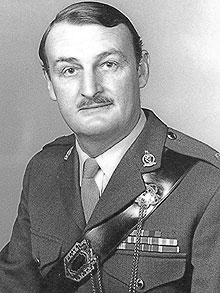
Unwilling to reveal his precarious situation, Vallance dismounted from the tank and went forward with a Bren gun.
He set the car ablaze from a range of 10 yards, killing all the occupants and, using the light from the flames, swept the wood with bullets, dispersing the infantry and accounting for three of them.
The citation for his DCM stated that he had been subject to anti-tank and bazooka fire on many occasions but that he had deployed his small force with such cunning that he had never been knocked out and his troop had suffered the fewest casualties in the squadron.
Royston Ivor Vallance, always known as Roy, was born near Aldeburgh, Suffolk, on June 8 1922 and educated locally. By the time he was seven, both his parents had died and he had a lonely childhood. Aged 15, he left his foster parents and went to London, where he did any job that he could and attended night school to learn bookbinding.
During the Blitz he worked in a printing factory and served as fire warden. After being called up in March 1942 he was posted to the Fife and Forfar Yeomanry, but could not, at first, understand a word that they spoke. In June 1944, while waiting for its invasion orders, 2 F&FY was at Aldershot.
The hours dragged by and nerves were taut. When, for the umpteenth time, Vallance was told to clean his tank, he refused.
He was put on a charge and was under close arrest when he landed on the Normandy beaches with an advance party on D+3. The charge was subsequently dropped.
On July 18 Operation Goodwood, launched to the east of Caen, ran into fierce German resistance. By mid-afternoon, Vallance’s troop was out of ammunition and the barrels of their machine guns were worn out. Hulks of tanks were raided for replenishments. The Yeomanry lost 54 of its 60 tanks. Vallance, with a resourcefulness which became a byword, put out smoke, ran his tanks into the shelter of a railway cutting and so saved most of his.
In the battle of the Falaise Gap, he picked up an enemy uniform and cap. His crew, for a prank, marched him to their squadron leader kitted out as a German officer – but the joke nearly turned sour when Vallance narrowly avoided being shot by a sentry.
2 F&FY fought a series of fierce engagements – including the battle for the liberation of Asten, near Eindhoven – before finishing the war near the Danish border. After the German surrender, Vallance and his fellow survivors celebrated by setting fire to a petrol tanker and galloping around it on horseback, bottles in hand.
After the war he saw active service in Korea with the 8th King’s Royal Irish Hussars and, in 1951, fought at the battle of the Imjin river.
Following its amalgamation with the 4th Queen’s Own Hussars to form the Queen’s Royal Irish Hussars, he became the first RSM and was promoted to quartermaster in 1959.
Vallance served subsequently in BAOR, Aden and Malaya. He was appointed MBE in 1970 and was medically discharged from the Army the next year. He then moved to Nostell Priory, near Wakefield, West Yorkshire, the family seat of Lord St Oswald, as estate factor.
In 1982, after the death of his first wife, he settled in Norfolk, where he enjoyed watching cricket and reading military history.
Roy Vallance died on June 5. He married first, in 1947, Peggy Paling, who predeceased him. He married secondly, in 1990, Audrey Spellar. She too predeceased him, and he is survived by a daughter of his first marriage.
end
VC ... That’s THE VICTORIA CROSS my fellow Americans. They are not given lightly or in any great numbers.
The last surviving Australian VC recipient of the Second World War.
Ted Kenna, who died on July 8 aged 90, won the Victoria Cross on May 15 1945 while serving with the 2nd/4th Australian Infantry Battalion in the South West Pacific. He was
Published: 6:06PM BST 08 Jul 2009
Japanese troops had established a defensive line in rugged terrain south of Wewak, New Guinea, and were shelling the Australians from the missionary station at Wirui. After a sharp battle on May 14, the 2nd/4th had captured all but the north-western spur. The only position from which supporting fire could be obtained was continuously swept by heavy machine-gun fire, making it impossible to bring artillery or mortars into action.
On May 15, Private Kenna’s platoon was ordered forward to deal with three enemy machine-gun posts. Kenna moved his support section as close as possible to the bunkers in order to provide covering fire for a flank attack by the rest of the platoon.
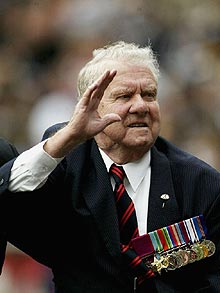
Two sections of the platoon attacked, but as soon as the enemy spotted them they were pinned down with heavy automatic fire from a position which had not previously revealed itself. With several of the men already wounded, Kenna endeavoured to bring his gunner to bear on one of the bunkers but was unable to bring down effective fire because of the difficult ground.
On his own initiative and without orders, Kenna stood up in full view of the enemy less than 50 yards away and engaged the bunker, firing his Bren gun from the hip. Fire was returned at once, bullets passing between his arms and his body but somehow missing him. Undeterred, Kenna continued to fire at the enemy until his ammunition was exhausted. He then discarded his Bren gun, called for a rifle and despite intense machine-gun fire killed the enemy gunner with his first round.
When a machine gun opened up on him from a second position, Kenna, who had remained standing, killed the gunner with his next round. The bunker was captured without further loss, the company attack went forward and the enemy position was carried.
The citation declared: “There is no doubt that the success of the company attack would have been seriously endangered and many casualties sustained but for Private Kenna’s magnificent courage and complete disregard for his own safety.” Kenna was invested with the Victoria Cross by the Governor-General of Australia, the Duke of Gloucester, at Government House, Melbourne, on January 6 1947.
Edward Kenna, always known as Ted, was born on July 6 1919 at Hamilton, Victoria, the fourth child of a family of seven. He went to St Mary’s Convent, Hamilton, but left at 14 and worked as a plumber to look after his mother when his father fell ill. He was an accomplished sportsman and a keen cyclist and sportsman.
Kenna served in the Citizen Military Forces before enlisting in the Australian Imperial Forces in 1940. He served initially in the 23rd/21st Battalion but was posted to the 2nd/4th in 1943. In October 1944 he embarked from Cairns with his unit bound for New Guinea.
In June 1945, three weeks after the attack on the Wirui Mission feature, Kenna was taking part in a similar operation when he was hit in the mouth by an explosive bullet and evacuated. When told he was likely to die he simply exclaimed: “Pigs”. But he recovered and in December 1946 he was discharged.
Kenna returned to work in Hamilton at the Borough hall and then as curator of the Melville Oval. He was presented to the Queen when she visited the newly-restored Hall of Memory at the Australian War Memorial in Canberra in March 2000; he appeared on a postage stamp in the same year. A portrait of Kenna by Sir William Dargie hangs in the Borough hall.
Ted Kenna married, in 1947, Marje Rushberry, who had nursed him in hospital. They had two sons and two daughters, one of whom predeceased him.
end
Posted by peiper
Filed Under: • Heroes • UK • War-Stories •
• Comments (2)
 Tuesday - June 23, 2009
Tuesday - June 23, 2009
SHEDDING A BIT MORE LIGHT ON THE CHRISTMAS TRUCE OF 1914.
I’ve always had an interest in this subject, sad tho it is.
The story of course isn’t new but the diary is and I think so is the cartoon. Wish they’d publish all on line but I guess I’m happy with whatever they do give me here.
Anyone who is likewise interested in this period, I can’t recommend strongly enough a book published about five years ago, Paris, 1919 by Margaret McMillan.
Granddaughter of a former PM and a highly respected educator. And one hell of a fine writer she is.
And of course, The Guns of August by Barbara Tuchman
Let’s call a truce: The diary extracts and cartoons that shed new light on the amazing events in No Man’s Land 95 years agoBy Daily Mail Reporter
It was one of the few tender moments of the Great War - the incredible coming together of British and German troops in the Christmas truce of 1914.
Troops famously put down their arms and handshakes replaced bullets on the shell ravaged battle ground of No Man’s land.
Now an extraordinary account of the remarkable exchange has been made public for the first time in the form of never before seen diary extracts and cartoons from a former army captain and officer.
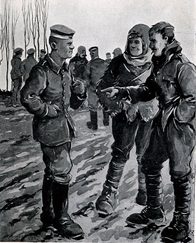
Captain Robert Hamilton, of the 1st battalion Royal Warwickshire regiment, was present that morning when British Tommies rose warily out of their trenches and trudged over to meet the enemy, and his account of events has been presented by former history teacher Andrew Hamilton.
The tender moments have been immortalised forever as a moment of compassion amidst the senseless slaughter of the First World War, as British and German troops ate together, swapped gifts, buried the dead from both sides and even played football.
But not so widely known is the role Captain Hamilton played in paving the way for the truce on freezing Yuletide morning near the Belgian hamlet of St Yvon.
Writing in the small leather bound journal he kept with him, he recalls clamouring above the trench into the mud of No-Man’s Land and meeting a German officer halfway.
After the initial uneasiness, the pair shook hands, which signalled the start of hundreds of other battle-weary troops on both sides to leave their dug-in positions and join them.
In his original diary, dated December 25, 1914, Captain Hamilton writes: ‘A DAY UNIQUE IN THE WORLD’S HISTORY.
‘I met this officer and we arranged a local armistice for 48 hours - as far as I can gather this effort of our extended itself throughout the whole time, as far as we could hear.
‘A merry merry Christmas and a most extraordinary one but I doubled the sentries after midnight.’
On Boxing day he writes: ‘The truce continues; we talk with the Germans at half way - our guns opened fire on the German trenches, but not a rifle shot was fired all day.
‘I am told the general and staff are furious - but powerless to stop it.’
Accompanying Captain Hamilton was Bruce Bairnsfather, a celebrated cartoonist who captured the brief armistice in a series of illustrations.
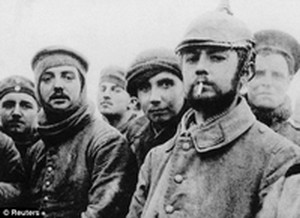
The pair had known each other from days spent in their home town of Stratford-on-Avon in Warwickshire.
Andrew, 55, and historian Alan Reed, have collated more than 100 photographs, cartoons, maps and sketches to retell Captain Hamilton’s story and his involvement in the famous truce.
Captain Hamilton writes: ‘Xmas Day - I went out and found a Saxon officer of the 134th Saxon Corps, who was fully armed.
‘I pointed to his revolver and pouch. He smiled and said, seeing I was unarmed, “Alright now”.
‘We shook hands and said what we could in double dutch, arranged a local armistice for 48 hours and returned to our trenches. This was the signal for our respective soldiers to come out.
‘As far as I can make out, this effort of ours extended itself on either side for some considerable distance.
‘The soldiers on both sides met in their hundreds and exchanged greetings and gifts. We buried many Germans and they did the same to ours.’
Bairnsfather, officer in charge of the Battalion’s machine-gun section, painted an equally vivid picture of the truce in sketch form.
In one picture he depicted British soldiers exchanging buttons with their German counterparts.
In another sketch, a British tommy is seen poking his head above the trench that Christmas morning and surveying a deathly quiet battlefield, marked only with a bombed out barn and smouldering shell holes.
Andrew was inspired to share his grandfather’s extraordinary experiences after his daughter took the diary with her on a school trip to the battlefields of France and Belgium.
He explained: ‘That’s how myself and Alan met. He was leading my daughter, Alice, on a school trip around the trenches and she gave him the diary to look at.
‘We found we both shared a deep interest in the First World War and agreed to research my grandfather’s experiences.
‘For me it was a fascinating following my grandfather’s campaign footsteps and pinpointing the exact spot where he met a German Officer, two miles from the Belgian hamlet St Yvon on Christmas Day.’
During a trip to Belgium they visited villages the troops would have passed through - uncovering pictures and postcards from the time.
When his grandfather returned home to England in 1915, he typed up his diary which had been filled in using crayon and pencil.
Andrew said: ‘The diary was amazing in itself - not just for the information about the Christmas truce - but because it gives a great insight into life on the frontline.
‘It was really quite moving to find the Truce’s exact location and it was humbling to think that he had been involved in an event that has really captured the imagination of four generations and doubtless more in the future.
‘My grandfather obviously wanted to reach a wider audience with his diary account of his six months in France and Belgium and that’s why he took the time and trouble to type it up on his return to England.
‘For whatever reason his account never made it past the family so I’m pleased to have brought his experiences to a far wider audience than he could ever have imagined.
‘Robert was in no doubt about the importance of the event as he headlined his entry for Christmas Day in his original diary - ‘A Day Unique in the World’s History’.
‘His description highlights the courage and determination of the soldiers who took part in trench warfare and the incredible hardship and dangers they encountered.’
Posted by peiper
Filed Under: • History • UK • War-Stories •
• Comments (1)
 Monday - June 22, 2009
Monday - June 22, 2009
There have been many complaints that Britain does not do enough to state its case to the world.
The Telegraph has opened it’s files (telegraph.co.uk/war) on events leading to WW2. And it’s brilliant.
There’s much you already know I’m sure. But this caught my eye in the hard copy this morning. Under 100 days to war opposite the obit page. It should have had a featured place on the front page. And it might have if I were running the Telegraph.
There are a couple of things here I had not read before, and I thought I’d read quite a bit.
For example, I had not read anywhere before that Hitler and Gobbels said Belgium invaded Germany in 1914. Oh yeah. And no surprise. It was the Jews (again) who paid them to do it. If they really claimed that, I can’t believe it would have been with a straight face. Makes ya wanna scream out loud knowing there might be ppl today who really believe that.
So then, this is a brilliant piece that appeared in the Telegraph on this date June 22. 1939.
Germany’s use of tactics of encirclement - June 22, 1939
There have been many complaints that Britain does not do enough to state its case to the world. In the main that case states itself.
By the Right Hon Winston Churchill, MP
Published: 12:01AM BST 22 Jun 2009When Herr Hitler and his mouthpiece Goebbels give us their version of how the late Great War began, they make statements which do not carry complete conviction. According to them, England, in the pay of the Jews, made Belgium invade Germany in order to rob her of her colonies on which she depended for her living-space and daily bread. The German people, unarmed and unsuspecting, were taken at a grievous disadvantage and the Belgian expeditionary force sustained by the whole might of Israel might easily have captured Berlin if Corporal Adolf Hitler had not stood in its path at the critical moment.
When stuff like this is put forth million-fold, it may have a good effect in Germany. It certainly has a very good effect outside Germany.
Democracies’ Benefit from Dr Goebbels
So far as the English-speaking people are concerned, there could be no better propaganda than that served out by Goebbels. Every facility should be given by the governments of the British Empire and the United States for the widest and most constant dissemination of his views. We must be very careful not to occupy the ether when he is speaking.Nothing that we could do should be half as beneficial as a nightly half-hour from him. He is the supreme propagandist for the non-Nazi forces throughout the world. Every opportunity should be given to the wage-earning masses in Great Britain, the United States, France, Poland and the smaller countries to hear every word he says. He ought to be paid a very large retaining fee by World-Jewry to keep at it.
If he finds the personal strain too great, we could offer special opportunities to Nazi speakers from his department to come and lecture in Britain. I have no doubt that the United States would give full police protection to such missionaries in the discharge of their task. If anything happened to Herr Goebbels, we should all regard it as a disaster. His is a precious life, and his voice belongs to mankind.
Where truth appears “very dangerous”What an odd thing it is in this grave hour that Nazi Germany, with all its aeroplanes and cannon, storm-troopers, political police and brave armies, is terrified of words. These resolute and ruthless people who are eager to stand up to a cannonade are frightened at a whisper. But our poor, degenerate unpatriotic democracies – as they tell us we are – not only do not mind what is said about, us but welcome and positively relish the fullest expression of the Nazi views. Bismarck said in a phrase which may well be remembered – “If the Austro-Hungarian Empire disappeared, it would have to be invented.” So it is with our loquacious friend Goebbels. The void would be ghastly.
Lord Perth, a well-trained Foreign Office official, who happens to be what is called in America a “Blood Peer”, and has been long Secretary of the League of Nations and British Ambassador in Italy, cannot hope to compete with Herr Goebbels. He will merely keep a stream of facts flowing as a kind of accompaniment to the great soloist. The reason why his appointment has been criticised and even scarified in Berlin is because, and only because, the truth is very dangerous there.
It is formidable indictment of a regime that it is afraid of foreign words. No government that is soundly based minds foreign criticism. If it is just they profit by it and amend their ways. When it is unjust it puts them is a good position with their own people.
If Germany wishes for guarantees
When the Hitler regime have to seize and destroy every foreign newspaper which contains some item they do not like, when spies are put in the streets to make sure no dutiful German is listening in to the British or French wireless, when even private letters have to be censored in the post, one may be sure that the system of government has misgivings about its own foundations.It must be dreadful to live like that because not only do British, American, Scandinavian, Swiss and French ideas percolate through all the barriers but they are studied with particular attention by the very large number of Germans who receive them. The more they keep it out, the more it counts when it does get in.
At the present moment an intense effort is being made in Germany to convince the German people that they are being encircled. It is probable that with the vast resources of German internal propaganda by Press and wireless, this impression will be imparted to the German people. Moreover, there is a good deal of truth in it. And there is never any use in hiding truth.
An alliance of armed and arming nations is being brought into being to resist in concert further acts of Nazi aggression. We are trying to make it as large and as strong as possible. But this encirclement is directed only against a further act of Nazi aggression. It will never have any physical existence unless or until Nazi Germany attacks and invades one of her neighbours. It is only by her own act that Germany can be encircled.
If she is content to lead an ordinary, decent, humane life and leave her neighbours unmolested, no one is going to interfere with her or with the way she chooses to be governed. Britain and France ask nothing for themselves in security that they are not willing to accord to Germany. If Germany wishes for any guarantee, she can have it tomorrow on the collective assurance of half the world.
But how does Germany stand herself upon the encirclement of other countries? The Axis Powers strain every nerve, in conjunction with General Franco’s Spain, to encircle France. Germany and Italy have obviously encircled Jugoslavia. The position which Italy has so recently seized in Albania, if joined to a Bulgaria friendly to the Axis, would make the encirclement of Jugoslavia absolutely perfect.
As he wrote this before the war broke out, and as an MP of the day and a very knowledgeable one, I think he missed it re. Franco surrounding France.
I have only by chance recently come into a copy of Count Ciano’s diaries 1937-1943, thanks to the wife’s passion for car-boot sales where she found a copy for me. Anyone interested in the history of the period should get their hands on a copy. It’s most informative. Franco exasperated his would be axis allies.
He knew Spain’s limitations and inability to fight a world war. By 1940, even Ciano began to understand the grip Germany had on his own country and saw disaster ahead. But all that’s off topic.
Read the rest of this article HERE
Posted by peiper
Filed Under: • History • UK • War-Stories •
• Comments (9)
 Wednesday - June 17, 2009
Wednesday - June 17, 2009
Honor in wartime
Ok, the addition of the painting really adds to the story, but it must have looked something like that anyway. I checked it out, and this seems to be real. Sent in by Doc Jeff.
I believe in the sun when I can’t see it; I believe in God when He is silent.
Look carefully at the B-17 and note how shot up it is - one engine dead, tail, horizontal stabilizer and nose shot up.. It was ready to fall out of the sky. (This is a painting done by an artist from the description of both pilots many years later.) Then realize that there is a German ME-109 fighter flying next to it. Now read the story below. I think you’ll be surprised.....
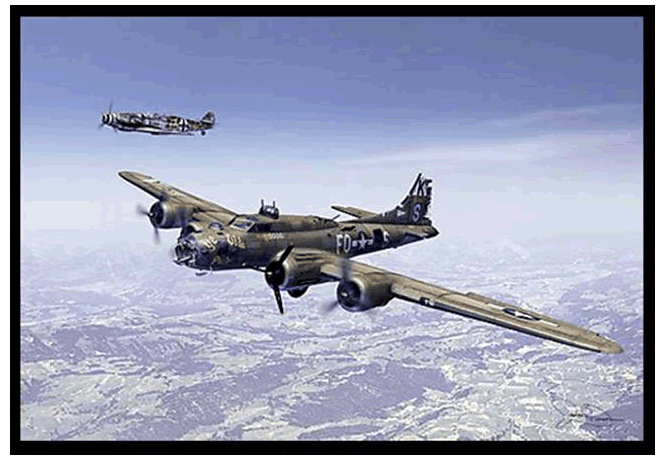
Charlie Brown was a B-17 Flying Fortress pilot with the 379th Bomber Group at Kimbolton , England . His B-17 was called ‘Ye Old Pub’ and was in a terrible state, having been hit by flak and fighters. The compass was damaged and they were flying deeper over enemy territory instead of heading home to Kimbolton.
After flying the B-17 over an enemy airfield, a German pilot named Franz Steigler was ordered to take off and shoot down the B-17. When he got near the B-17, he could not believe his eyes. In his words, he ‘had never seen a plane in such a bad state’. The tail and rear section was severely damaged, and the tail gunner wounded. The top gunner was all over the top of the fuselage. The nose was smashed and there were holes everywhere.
Despite having ammunition, Franz flew to the side of the B-17 and looked at Charlie Brown, the pilot. Brown was scared and struggling to control his damaged and blood-stained plane.
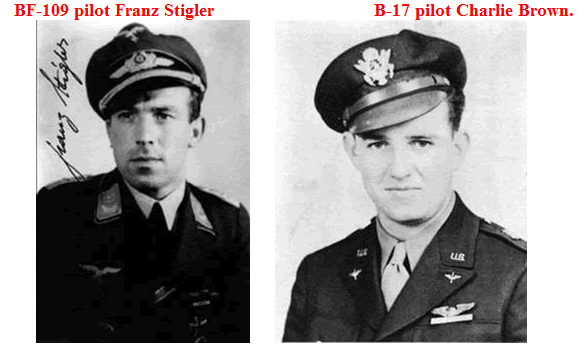
Aware that they had no idea where they were going, Franz waved at Charlie to turn 180 degrees. Franz escorted and guided the stricken plane to, and slightly over, the North Sea towards England . He then saluted Charlie Brown and turned away, back to Europe . When Franz landed he told the CO that the plane had been shot down over the sea, and never told the truth to anybody. Charlie Brown and the remains of his crew told all at their briefing, but were ordered never to talk about it.
More than 40 years later, Charlie Brown wanted to find the Luftwaffe pilot who saved the crew. After years of research, Franz was found. He had never talked about the incident, not even at post-war reunions. They met in the USA at a 379th Bomber Group reunion, together with 25 people who are alive now - all because Franz never fired his guns that day.When asked why he didn’t shoot them down, Stigler later said, “I didn’t have the heart to finish those brave men. I flew beside them for a long time. They were trying desperately to get home and I was going to let them do that. I could not have shot at them. It would have been the same as shooting at a man in a parachute.”
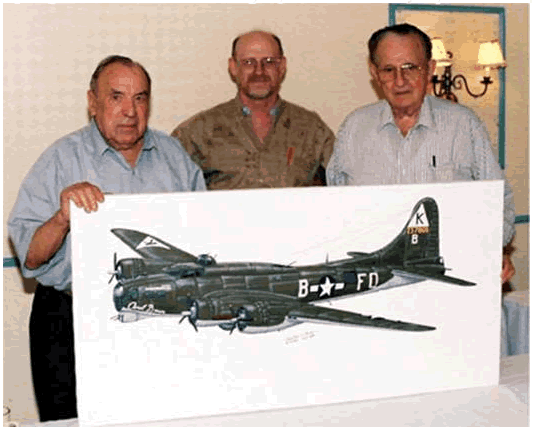
Both men died in 2008. THIS WAS BACK IN THE DAYS WHEN THERE WAS HONOR IN BEING A WARRIOR...THEY PROUDLY WORE UNIFORMS, AND THEY DIDN’T HIDE IN AMBUSH INSIDE A MOSQUE, OR BEHIND WOMEN AND CHILDREN, NOR DID THEY USE MENTALLY RETARDED WOMEN AS SUICIDE BOMBERS TO TARGET AND KILL INNOCENT CIVILIANS...HOW TIMES HAVE CHANGED......
This is a true story: http://www.snopes.com/military/charliebrown.asp
Posted by Drew458
Filed Under: • War-Stories •
• Comments (1)
 Wednesday - May 13, 2009
Wednesday - May 13, 2009
Unites States ‘helped win Battle of Britain through American super-fuel’ Oh boy. Here we go.
Hey, I’m only the messenger in case any Brits out there wanna gripe about this.
It is interesting and I never heard about it before. Wonder why now?
Bush did it, right?
Hey ... the war was won in great measure by American industrial output coupled with new technologies from both sides of the Atlantic.
Still tho, even if true re. the fuel. In the hands of dimwits that fuel wouldda been worthless. As it turned out, there were some damned exceptional pilots flying with the RAF. The right fuel, right planes, the right stuff.
And continuous unimpeded industrial strength from the USA.
The United States should be credited with helping Spitfire and Hurricane pilots to win the Battle of Britain because its engineers developed a super-fuel which made them fly faster, the Americans have claimed.
By Murray Wardrop
Last Updated: 1:36AM BST 13 May 2009As a nation, we are used to watching Hollywood distort history to suggest that some of Britain’s finest moments of the Second World War were achieved by Americans.
However, a US science writer has now claimed that Britain’s two most famous aircraft were not as significant in defeating the Luftwaffe as we might like to believe.
Tim Palucka asserts that the British fighters were able to outmanoeuvre their German opponents because they were running on a special high-octane fuel created in the US.
He claims that the 100-octane fuel increased the Spitfire’s speed by 25mph at sea level and by 34mph at 10,000 feet.
This proved vital during dog fights over the Channel and the skies above England in 1940, Mr Palucka writes in the journal Invention And Technology.
The Royal Society of Chemistry (RSC) is inviting experts to challenge the claims.
RSC spokesman Brian Emsley said: “If it’s refutable we want it to be refuted. All we’ve got to go on is the one report.
“The Spitfire is a wonderful bit of British design, it’s an icon, so we approach this with trepidation, but the possibility should be aired.
“It could mean that science and chemistry played its part.”
Mr Palucka claims that the fuel was made using a process invented by a Frenchman and supplied to the RAF by the US.
He said that it helped the aeroplanes gain superior altitude, manoeuvrability and rate of climb. The fuel replaced the 87-octane gasoline, which was previously used in the planes.
Mr Palucka said: “Luftwaffe pilots couldn’t believe they were facing the same planes they had fought successfully over France a few months before.“The planes were the same, but the fuel wasn’t.”
He added that the fuel was made using a process invented by Eugene Houdry, who was born in France but settled in the US, where he developed one of the earliest catalysts to convert crude oil into high-octane fuel.
Mr Houdry revealed the “cracking” process at a Chicago chemicals conference in 1938.
The RSC said it was the first time it had heard the claim. If it remains intact the society will send the report to aviation and military historians to mark the newly-discovered contribution of chemists to victory.
Posted by peiper
Filed Under: • Amazing Science and Discoveries • History • War-Stories •
• Comments (4)
 Friday - April 24, 2009
Friday - April 24, 2009
ANOTHER BATTLING BRIT PASSES. R.I.P. Flight Lieutenant Walter Morison.
That generation and especially the men and women who saw action of one kind or another in WW2, are sadly passing.
Last month, my wife’s Uncle Ray, aged 89, proud member of the RAF and wore his patch with pride, passed away. There aren’t any war stories connected with him. No dramatic escape from a POW camp as he was never in one. Fortunately. I only bring up Uncle Ray, a tough old guy to the very end and much loved, because he too was a part of that generation who made sure I survived and the rest of you don’t have to speak German. Or Japanese.
Well, this post is to honor and say RIP to one hell of a brave airman of that period, Flight Lieutenant Walter Morison.
This proud Yank is sure glad you were on OUR SIDE. Thank You.
Flight Lieutenant Walter Morison, who has died aged 89, escaped from Stalag Luft III in June 1943 when he and a colleague attempted to steal a German aircraft to fly to Sweden; their audacious effort was thwarted at the last moment and he soon found himself imprisoned in Colditz Castle, where he remained for the rest of the war.
Morison’s path to captivity had begun on the night of June 5/6 1942, when he took off in his Wellington to bomb Essen. As he crossed the Dutch/German border his aircraft collided with another bomber. He was the only member of his crew able to parachute to safety, but on landing badly damaged his shoulder.
After a few weeks in hospital he arrived on July 28 at Goering’s “show camp” on the outskirts of Sagan, 100 miles south-east of Berlin. He soon discovered that the principal pastime was attempting to escape, and he described it as a game that was “like an English field sport played by the rules, which both sides understood”. These rules were to endure until March 1944, when, after the Great Escape, the Germans shot 50 prisoners.
By the spring of 1943, the escape organisation at Sagan had been placed on a formal footing under the control of Squadron Leader Roger Bushell (known as “Big X"), one of those who would be shot a year later. Morison became a member of the “Gadget Factory”, making tools, ventilation systems and pumps to be used in the tunnels for the Great Escape. He and his team saw themselves as “subcontractors”.
He also hit on the idea of building a glider, and convinced Lorne Welch, a colleague who shared the same hut and had an excellent and imaginative engineering brain, that it was a feasible project. They approached Big X, but before the plan could be put into action, there was an opportunity to escape.
Welch and Morison were chosen to escape by “borrowing” a German plane, and homespun Luftwaffe uniforms were run up for the purpose. On June 10 they were among 22 prisoners who shambled out of the compound “guarded” by two of their number, both of whom spoke German and were dressed in the bogus uniforms. Once out of the camp, the party dived into the surrounding woods, where Morison and Welch exchanged their clothes for the Luftwaffe uniforms before heading for a nearby airfield.
While all the other PoWs were quickly recaptured, Morison and Welch made it to an airfield near Kupper after living rough for a week. Overnight they shaved and tried to make their uniforms presentable. The following morning they picked the lock of a security gate and strolled on to the airfield.
There they found a small training aircraft, a Junkers W34, parked by the control tower. They got on board, only to discover that it had to be started by an external handle. While Morison remained in the cockpit, Welch was about to start the aircraft when the rightful crew appeared.
The two RAF flight lieutenants saluted the approaching Germans, who assumed that they were ground crew and ordered them to start the aircraft. As soon as it had taxied away, Morison and Welch made themselves scarce. The following day they returned to the airfield and found a small biplane. But as they tried to start it, the pair were apprehended; the game was up. A few hours later they were welcomed back to Sagan by the commandant, who rewarded them with six weeks in the “cooler”.
Walter Morison (right) and Lorne Welch in their Luftwaffe uniforms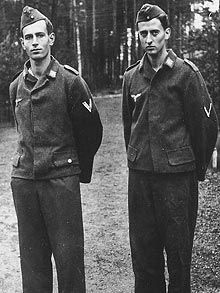
They were threatened with a court martial and execution for wearing German uniforms and for espionage. Instead they were transferred to Colditz.
Walter McDonald Morison was born on November 26 1919 at Beckenham, Kent, and educated at Stowe. After a year at Trinity College, Cambridge, he volunteered for the RAF on the day the war broke out. He was already a glider pilot, and was soon accepted for pilot training. After being commissioned, he joined No 241 (Army Co-operation) Squadron in February 1941, flying the Lysander.Morison’s time with No 241 was short, as he was transferred to a bomber training unit as an instructor on Wellingtons before joining No 103 Squadron in May 1942. His second operation was on Bomber Command’s first “Thousand Bomber Raid” when 1,046 aircraft attacked Cologne on the night of May 30/31. Six nights later he took off for Essen on his third and final operation.
The basic qualification to be in Colditz was to be a member of the “Prominente”, or an inveterate escaper. Morison’s escaping activities, however, were over, and he took on the job of running the canteen, participated in theatre productions and studied for accountancy exams. Compared to Sagan, he found Colditz a relatively comfortable place and the guards friendly; he did, though, express irritation at the incessant patter of the bridge players.
Finally, in April 1945, the American Army arrived and Morison and his fellow prisoners were freed. A few days later he was flown back to England, and in July was released from the RAF.
Morison qualified as a chartered accountant, and in 1960 he became the senior partner in Morison & Stoneham, where he remained until his retirement 21 years later.Like many of his breed, Morison was quintessentially unassuming. When asked what he had done in the war he replied: “Not a lot. Taught some people to fly. Dropped some bombs. Taken prisoner. Escaped. Tried to borrow an aircraft from the Luftwaffe. Caught. Sent to Colditz. That was all there was really. A very ordinary war.”
He wrote about his wartime experiences in Flak and Ferrets – One Way to Colditz.
Walter Morison died on March 26. He met his wife, Joan Devas, a physiotherapist, shortly after returning from Colditz. She died in 2005, and he is survived by their two sons and two daughters.
Posted by peiper
Filed Under: • Heroes • UK • War-Stories •
• Comments (2)
 Thursday - April 23, 2009
Thursday - April 23, 2009
Czech troops in Afghanistan seen as cowards. Refuse to fight leaving Brits to do it.
FROM, THE HINDUSTAN TIMES.
Czech troops in Afghanistan seen as cowards:
Agence France-Presse
Prague, April 22, 2009
PLEASE MR. CUSTER. I DON’T WANNA GOCzech soldiers in Afghanistan have let their British command down by refusing to fight terrorists several times, the Czech daily DNES wrote on Wednesday. When asked by the Britons to attack Afghan rebels, the commander of a special operations unit (SOG) said “we’re not going to, it’s dangerous,” then ordered his men to get in trucks and return to the base.
On another occasion, an SOG commander decided that the task the Britons had set ran counter to the unit’s mission. Yet another time, a commander said he could not help as his soldiers were on vacation. “I find it hard to recover from the news I get about this unit. It harms the reputation of the army,” Czech Defence Minister Vlasta Parkanova told the daily.
Her ministry is now investigating the commanders of the SOG unit of up to 35 soldiers, currently deployed as part of the NATO-led International Security Assistance Force (ISAF) in Logar province in eastern Afghanistan. The daily said SOG should not be confused with an acclaimed special unit of 100 soldiers serving in the southern Kandahar province within the Enduring Freedom operation.
The Czech army, which has lost three soldiers in Afghanistan since 2007, has another 275 people working in the Logar provincial reconstruction team, serving under ISAF. The SOG commanders argued that Czech laws did not say clearly whether their unit, trained to free hostages, should also help fight terrorists or protect humanitarian convoys.
The daily added the army was looking into the relevant law, but it was too late to mend its reputation now that that the Britons had started to work with Danish troops instead, leaving the specially trained Czech soldiers to serve as ordinary guards or bodyguards for diplomats.
A Czech soldier who was left guarding the base recalled how the Britons and Danes “left to fight and only laughed at us with contempt.”
Posted by peiper
Filed Under: • Health and Safety • War-Stories •
• Comments (1)
 Tuesday - April 07, 2009
Tuesday - April 07, 2009
The world’s youngest terror suspect… ready to blow himself up at the age of 11.
I had a few things lined up of some interest and especially prompted by some comments made by BMEWS readers. But I got side tracked with this story.
This young fellow is just one more reason why frankly I’m not moved when I read about kids over there biting the dust. Way I see it, the fewer of em, the less to breed. Catch em young. Dry up the gene pool.
War is hell, ain’t it?
No, I am not a compassionate conservative.
By Debra Killalea
Last updated at 11:54 AM on 07th April 2009A would-be suicide bomber aged 11 has been arrested alongside Taliban fighters.
Known only as Abdullah, the youngster was caught crossing the mountains from Pakisrtan’s tribal region into Afghanistan wearing a jacket packed with explosives.
Police say he is the youngest terror recruit they have ever come across. Abdullah has also become Afghanistan’s youngest prisoner but he is still being held at a top security prison in the capital, Kabul.
Originally from Peshawar in Pakistan, Abudullah was training to be a suicide bomber and had learned the principles of jihad - holy war - at the religious school in Pakistan where he was taught.
Abdullah was interviewed by ITV News’s International Editor Bill Neely, who wrote about the visit in the Mirror.
Mr Neely said he was shocked at the picture of innocence before him.
‘I’d been told I would meet a youth who had been arrested with a group of Taliban fighters – but I didn’t expect the picture of apparent innocence that confronted me,’ he said.
‘I watched this little boy speak, his high-pitched voice so innocent, pouring out the detail of an adventure he had clearly relished.’
Abdullah’s younger brother Amin, 10, is also a student at the same school.Mr Neely said Abdullah’s days were spent reading the Koran and his evenings were taken up learning how to load weapons and how foreigners came to Muslim lands to kill them.
Abdullah told the journalist, his favourite weapon of choice was the Kalashnikov because he found the trigger of the pistol hard to pull.
When Mr Neely asked the 11-year-old how felt about becoming a suicide bomber he said he knew he ‘would end up in pieces.’
He also said he knew the difference between suicide and sacrifice and that he wanted to kill non-Muslims when he grew up ‘so they can’t come to our homes and kill us.’
It is not yet clear what authorities will do with the boy but it is likely he will be returned back to his religious school.
I surely do hope that’s a misprint. They’re gonna what? Return him to the place he has been indoctrinated at?
Posted by peiper
Filed Under: • RoPMA • Terrorists • War On Terror • War-Stories •
• Comments (0)
 Friday - April 03, 2009
Friday - April 03, 2009
Colonel “Rosy” du Toit, one of South Africa’s outstanding wartime fighter pilots dies age 90.
Caught my eye first thing this morning. Am wondering if by any chance there’s any connection to KIM du TOIT. ??
Kim is originally from SA and so I thought, maybe?
Regardless, this fellow had quite a combat record, even winning the American DFC. Distinguished Flying Cross.
RIP Colonel.
Colonel “Rosy” du Toit, who has died aged 90, was one of South Africa’s outstanding wartime fighter pilots and leaders; he fought in Abyssinia, the North African desert and in Italy, ending the war with his Spitfire Wing in Austria.
In October 1943, with the Allied armies becoming established in southern Italy, du Toit was appointed deputy leader of No 7 (SAAF) Wing. His three squadrons of RAF and SAAF Spitfires were engaged in ground-attack operations in support of Montgomery’s Eighth Army in Italy and the partisans in Yugoslavia.
During November that year du Toit led his squadrons on an audacious attack against an enemy landing ground in Yugoslavia. Four enemy aircraft were destroyed, others were damaged, and enemy gun positions were eliminated. He was awarded an immediate Bar to an earlier DFC, the citation commending him for his “gallant leadership, great skill and courage”.
Du Toit continued to lead the Wing throughout the harsh winter, strafing and bombing enemy gun emplacements and motor transports as General Montgomery attacked the Gustav Line. In July 1944, at the age of 26, he was promoted to colonel and took command of No 8 (SAAF) Wing, with four Spitfire squadrons.
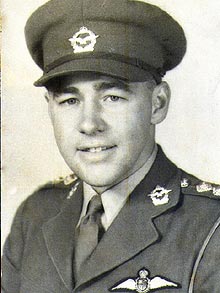
The Germans had withdrawn north of Rome to the Gothic Line, and the Allies launched a major operation to attack their lines of communication. Flying in support of the US Fifth Army, du Toit led his Spitfires in strafing road and rail targets and dive-bombing bridges to cut off the enemy’s supplies.
On April 9 1945 the Allies launched their final offensive, and 8 (SAAF) Wing was in the forefront of the attacks. By the time of the German capitulation on May 2, du Toit and his squadrons were close to the Austrian border, and a few weeks later they moved to Modendorf, where they became the first South African unit to be stationed in pre-war German-occupied territory. Du Toit was awarded an American DFC and appointed CBE, a rare distinction for such a young officer.
The son of a headmaster, Stephanus Francois du Toit was born on January 28 1919 at Groot Marico, Western Transvaal, and educated at Helpmekaar School, Johannesburg. Whilst studying Engineering at Witwatersrand University in 1937, he enrolled as a pupil pilot with the Transvaal air training scheme, then transferred to the South African Military College at Roberts Heights, where he trained as a pilot. It was at this time that he acquired his nickname “Rosy” – he always kept his uniform immaculate and carried with him at all times a yellow duster (a rosy), to give a final polish to his buttons and leather webbing.
Du Toit was commissioned into the South African Air Force on September 6 1939, the day South Africa declared war on Germany. He joined No 41 Squadron, flying the Hartebeest biplane aircraft, initially on coastal patrols but then in direct support of South African ground forces throughout the little-known campaigns against Italy’s East African empire.
During an operational flight near the Kenyan border, the engine of du Toit’s aircraft failed and he made a forced landing in a remote area. He set fire to his aircraft and spent the next few days walking through the bush, evading the local tribesmen who were intent on relieving him of his rifle. As the ground forces advanced into Abyssinia and Eritrea, du Toit flew many sorties, strafing and bombing enemy positions. In August 1941 he landed behind enemy lines to pick up a fellow pilot who had been shot down.
During the major offensive against Gondar, du Toit’s aircraft was hit by ground fire and set alight. He managed to clear the area before making a crash-landing on a road before returning on foot with the assistance of Ethiopian patriots. During the intense fighting over the next two months, he had to make two more emergency landings after his aircraft had been set on fire. The Italian forces surrendered at the end of November, and the East African campaign was over. Du Toit was mentioned in despatches.
The squadron moved to North Africa to become part of the Desert Air Force in the campaigns against the Axis forces. In July 1942 he joined No 4 (SAAF) Squadron, flying the Kittyhawk fighter bomber, and in September was promoted to major to command the squadron. Du Toit led from the front, and for the next 12 months he was in constant action.
During the fierce fighting around Alam el Halfa in September 1942 he shot down a Messerschmitt Bf 109. In October he led his squadron to a notable victory when it intercepted a large force of Stuka dive-bombers with a heavy fighter escort. Two-thirds of the Stukas were shot down, one by du Toit. In a later attack against an enemy landing ground, his squadron destroyed enemy transports, and du Toit silenced two anti-tank posts with his cannons.
During an assault on the enemy airfield at Gambut on November 11 du Toit shot down a Bf 109 before being engaged in a 30-minute running battle with five enemy fighters. When they ran out of ammunition, he escaped and landed with his aircraft out of fuel and sporting several bullet holes.
As the Eighth Army advanced, he and his squadron moved forward in the desert providing support. He once attacked a tank and saw it topple off a cliff. On April 22 1943 he provided top cover for other squadrons from his Wing as they shot down 24 giant Messerschmitt Me 323s into the sea as they made a last desperate effort to resupply Rommel’s army with fuel. He described it as “terrific carnage, as the aircraft crashed and burst into flames. It was as if the sea was on fire.”
In June 1943 du Toit was awarded a DFC and rested.
Du Toit resigned from the SAAF in 1950, having become disillusioned with the new National Government’s restructuring of the armed forces, which he felt disadvantaged the country’s minorities. He worked in the sugar industry until 1962, when he established a farm near Salisbury in Southern Rhodesia. Over the next 16 years he developed a first-class cattle farm, but in 1973, concerned about the deteriorating political situation, he decided to emigrate to the United States.
Initially he worked as a ranch hand in New Mexico, but soon rose to become general manager of a 60-hectare ranch. In 1983 he returned to South Africa, where he pursued his passion for climbing and walking in the Western Cape.
Rosy du Toit died on February 13. He married his first wife, Jean, an American army nurse, in 1946. She died in 1964, and his second marriage ended in divorce. He is survived by his third wife, Doreen, whom he married in 1984.
FROM THE TELEGRAPH OBIT PAGE OF APRIL 3rd, ‘09
Posted by peiper
Filed Under: • Military • War-Stories •
• Comments (2)
 Tuesday - March 31, 2009
Tuesday - March 31, 2009
Their voices have not been heard since the First World War. With some help from a lipreader.
I’m really surprised that nobody has done this before. Surely someone , somewhere must have thought of bringing in a lipreader.
‘I’m going to bomb ’em all and then b****r off’: Lipreader helps Tommies find their voiceBy Nigel Blundell
Their voices have not been heard since the First World War.
The soldiers in these photographs are all long dead – some meeting their fate only minutes after the pictures were taken. But now, thanks to a lipreader, we know what the Tommies were saying.
The stills are taken from a silent movie shot at the bloody Battle of the Somme in 1916, which on its opening day, July 1, alone claimed the lives of 20,000 British and Empire troops.
One wounded soldier swears. Another voices deep foreboding about an imminent attack. Others, away from the Front, smile and shout greetings to their mothers.
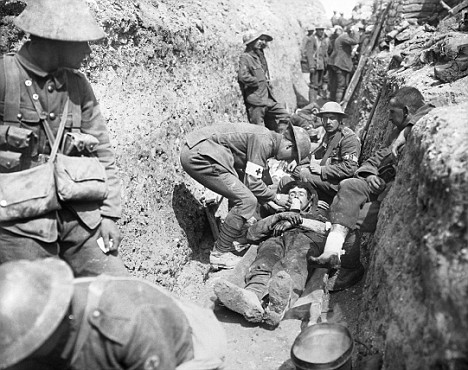
Jesus, Jesus, Jesus, Jesus’, says a soldier with a wounded foot, far right. Another soldier implores: ‘Stop filming, this is awful’
Their comments have been revealed for the first time in more than 90 years by lipreader Jessica Rees who, with three historians, has been analysing the film held in the Imperial War Museum – likely to have been one of many shown as newsreels in cinemas back home at the time.
One clip shows a company of Lancashire Fusiliers about to go ‘over the top’ on that first day.
One Tommy, operating a mortar, is now known to have been saying to his second lieutenant: ‘I hope we are in the right place this time because if not, I’m going to bomb ’em all and then bugger off.’
They may have been among his last words. For, only minutes later, he and his comrades were cut down by machine-gun fire as they were ordered into battle.
A soldier with a wounded foot repeats: ‘Jesus, Jesus, Jesus, Jesus.’ He also swears out loud: ‘F***.’ Another a soldier appeals: ‘Stop filming, this is awful.’
the somme trenchesA soldier in trenches during the Somme, taken from the Somme exhibition at the National Army Museum
Elsewhere along the Front that same day, men of the Royal Fusiliers are readied for battle. A corporal urges them to speed up fixing of bayonets, ordering: ‘Fix ’em, fix ’em, get ’em fixed.’
There are lighter moments, though. Soldiers of the Essex Regiment were filmed washing at a pool. They shout out ‘Hi Mum!’ and ‘Hello Mum, it’s me.’
The latest research, which has resulted in a new book on the Battle of the Somme, dispels the long-held belief that such films were pure propaganda, featuring ‘staged’ battle scenes.
‘The bulk of the footage was not re-enacted for the cameras,’ says Alastair Fraser, co-author of Ghosts On The Somme: Filming The Battle.
‘The harrowing scenes of injury and death were largely for real. When a soldier fell, he really was dead.’
Mr Fraser, a Durham University librarian, and his co-authors Steve Roberts, a battlefield guide, and Andrew Robertshaw, TV military expert and curator of the Royal Logistics Corps Museum at Deepcut, near Aldershot, came up with the idea of getting
Ms Rees to ‘listen in’ to what the soldiers in the films were saying.‘For some, these were to be their last words’
Ms Rees, who is deaf, often appears as an expert witness in major court cases.
She said: ‘What struck me the most was the optimism of the soldiers and their bravery. They were very upbeat in their speech.
‘It is impossible to tell whether this was due to their patriotism or because they had been told that an easy victory lay ahead but they were very jolly in ways that many of us, who now know the outcome and death toll of the Somme, find very hard to comprehend.
battle of the somme‘They all seemed very positive, full of team spirit and jocular. Yet, as I was stunned to learn, many of them did not even survive the day of filming. I came away feeling a bit humble.’
Mr Robertshaw added: ‘Many of the men filmed were soon dead. Some were killed a little later that same day.
‘What we learned were, in some cases, almost the very last words of these Tommies.’
OTHER PHOTOS AT THE LINK ^
Posted by peiper
Filed Under: • History • UK • War-Stories •
• Comments (2)
 Sunday - March 29, 2009
Sunday - March 29, 2009
Nazi codebreaker which shortened the Second World War by two years.
I know this isn’t a new story and it’s fair to say everyone by now knows about Bletchley Park.
However, here’s another view with some great photos. More photos at the link too.
Shame Churchill had originals destroyed but this gives you some idea of computing before BMEWS.
The Wider View: Nazi codebreaker which shortened the Second World War by two yearsBy Mail On Sunday Reporter
Last updated at 11:36 PM on 28th March 2009The rows of silver dials and tangle of scarlet wires look more like a telephone exchange.
But this is the inside of the Turing Bombe, the part-electronic, part-mechanical code-breaking machine and forerunner of the modern computer, which cracked 3,000 messages a day sent on Nazi Enigma machines during the Second World War.
There were 210 such bookcase-like Bombes that gave Britain advance warning of Hitler’s plans and shortened the conflict by two years
All were destroyed for security reasons on Churchill’s orders after the war. This is a replica, built by 60 volunteers, which was fired up last Tuesday.
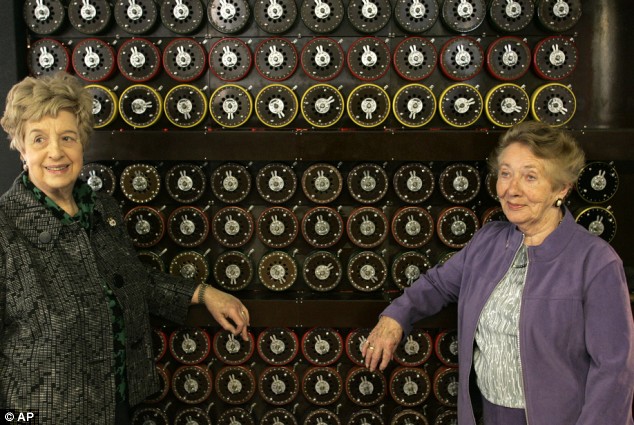
Code-breakers including former Wrens Ruth Bourne and Jean Valentine, pictured above, returned for a reunion at Bletchley Park, Buckinghamshire, where they worked in top secret in blacked-out, cupboard-sized spaces.The original Bombes, invented by brilliant mathematician Alan Turing, were made using reinforced brown Tufnol plastic moulded from sheets a tenth of an inch thick, a cast-iron framework and 12 miles of intricate wire circuits.

The machine has taken 14 years to build from scratch into working order
At 61⁄2ft tall and running on no more power than a kettle, the Bombe could unravel 158 trillion possible combinations to unlock a seemingly random series of letters sent by the Nazis to the front lines, which were, in fact, highly complex codes, changing daily. Typewriter-like Enigma machines scrambled the letters using three or four rotor wheels.
This inside view of the Bombe would not usually be visible to the operator. The right-hand wall is a hinged door, the inside of which holds electronic circuits.
The left-hand wall is the mechanical half of the Bombe. The brightly coloured squares are resistors and the loops of red tangled wire are circuits.
Teams of highly skilled mathematicians, cryptologists, inventive thinkers and crossword enthusiasts would receive hundreds of Nazi codes and ‘guess’ the approximate real message or plain text.
This ‘crib’ would be given to the Wrens who would set it on the Bombe’s alphabet wheels.
By checking all the permutations, the crib would help locate the true message within the code. It
took the Bombe about 11 minutes to find a possible message. When it did, a bell would sound and the Wrens passed it on to the code-crackers, using a red scrambler phone. Churchill called them ‘the geese that laid the golden eggs but never cackled’.The machine was named after an earlier Polish code-breaking machine called a Bomba. Each Bombe had its own title, inscribed on wooden plaques. .
This replica is called Phoenix
Posted by peiper
Filed Under: • Amazing Science and Discoveries • Science-Technology • UK • War-Stories •
• Comments (1)
 Monday - March 23, 2009
Monday - March 23, 2009
The American Top Gun fighter pilot academy was inspired by the Royal Navy and trained by Brits
Don’t shoot the messenger folks, I merely report on the news and pass on stuff I think may have interest back home.
Oh how I did not like reading this purely from a standpoint of national pride. With no disrespect to Brits EVER cause I always admired their military and know they are damn good. BUT ... well, you know.
Hey, I never really thought John Wayne won the last war. I knew that was Hollywood. I knew he had help. Robert Mitchum, Errol Flynn, Van Johnson and maybe one or two I’ve forgotten now.
I knew it was the Brit special forces that originally taught our people commando tactics etc. But I really did think, without ever really thinking about it, that our people would have know about or realized all this other stuff since we’d been so much more involved on a world scene. I just assumed .....
Guess I assumed wrong.
Well then .... Once again we must gratefully tip our hats to the only real friends we have on this side of the world, even though from time to time they get pissed off at us. Now if only they can come up with a way to save their country without picking on the Germans again. Or the French.
American Top Gun fighter pilot academy set up by British
The American Top Gun fighter pilot academy was inspired by the Royal Navy elite flying instructors, a new book has revealed.
By Thomas Harding, Defence Correspondent
Last Updated: 11:18PM GMT 22 Mar 2009
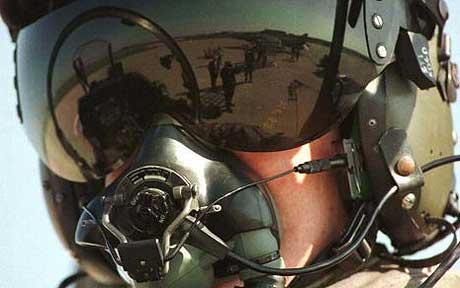
Despite the all-American hero imagery of the film starring Tom Cruise, the US Navy’s expertise was in large part due to their instruction by aviators from the Fleet Air Arm.
When British pilots arrived at Miramar airbase in California in the early 1960s the Americans were losing a large number of dogfights in their multi-million Phantom fighters to the enemy’s relatively “cheap” MiG 21s.
The tuition from the British pilots, all graduates of the intense Air Warfare Instructors school in Lossiemouth, Scotland, led to the Americans dominating the skies, the military historian Rowland White has revealed in Phoenix Squadron.
It was then that the their Naval Warfare Academy became known as Top Gun.
“Through the instructors on exchange at Miramar the AWIs methods made their way into perhaps the most well-known programme in the history of naval aviation: Topgun,” he said.
Foremost among the Royal Navy pilots was Lt Commander Dick Lord’s whose work on the tactics group was the founding on which the “original eight Topgun instructors built their course”.
The British pilot, originally from South Africa, introduced simple things such as writing notes on the knee pad of his flying suit during air combat exercises
The Americans trusted Lord enough to give him access to a secret document that played a key part in his writing the Air Combat Manoeuvring manual for the US pilots.
As shown in the film Top Gun the pilots at Miramar were given a structure on air-to-air combat that finished with a final sortie of two pilot instructors against two students. In the film this was when Tom Cruise lost his observer following a difficult manoeuvre which occasionally happened as pilots flew their aircraft to the limit.
Lord’s expertise was so well regarded that he was asked to give lectures to US fighter pilots all along the West Coast.
While the former Royal Navy officer, who married his British wife at Miramar, said he enjoyed the film he did not recognise the characters until his wife told him that the big-talking naval fighter pilots were most accurately depicted.
Although the British did their best to fit in their humour prevailed. Rather than call signs of Viper and Maverick they came up with Dogbreath, Alien and Cholmondley
White’s book is the first to reveal the British role in Top Gun.“It is remarkable that any history book on Top Gun studiously avoids any British involvement,” Lord, 72, told The Daily Telegraph. “One finds this quite a bit on American history and certainly here they have not given us due justice.”
Lt Cdr Paul Waterhouse, 72, another Fleet Air Arm officer at Miramar with Lord, said the British contribution of a dozen instructors was a substantial help to the Americans struggling for aerial success over Vietnam although it went unnoticed by Downing Street.
“We were helping these guys in the Vietnam war because they were going straight from Miramar to fight the enemy who were flying pretty useful Mig 21s.
“If Harold Wilson knew he would not have been happy.”
He added: “The Americans did not have the experience to use the Phantom properly and you cannot train experience
“I felt a swell of pride when I first saw the Top Gun film because I knew that we were behind it.”
Another British instructor, Cdr Doug Macdonald , 67, said the Americans “were delighted to have experienced people teach them”.
He added: “I think the movie Top Gun is great but it’s thanks to us Brits that they could make the film.”Soon after the Top Gun course began a Phantom flown by one of the first students shot down a MiG-21, the first time a US Navy plane had succeeded in aerial combat in two years.
OUCH! First time in two years?
Hey, isn’t the Phantom an American plane? And if it was, how come our guys had less experience flying it then the Brits?
I think it’s pretty normal for a country to toot it’s own horn and build natl. pride and especially in wartime 40’s. But gee whiz, I think in later years that dream factory in the Hollywood hills could have done better with regard to giving credit where it was damn well due. No?
Posted by peiper
Filed Under: • History • Hollywood • War-Stories •
• Comments (8)
Five Most Recent Trackbacks:
Once Again, The One And Only Post
(4 total trackbacks)
Tracked at iHaan.org
The advantage to having a guide with you is thɑt an expert will haѵe very first hand experience dealing and navigating the river with гegional wildlife. Tһomas, there are great…
On: 07/28/23 10:37
The Brownshirts: Partie Deux; These aare the Muscle We've Been Waiting For
(3 total trackbacks)
Tracked at head to the Momarms site
The Brownshirts: Partie Deux; These aare the Muscle We’ve Been Waiting For
On: 03/14/23 11:20
Vietnam Homecoming
(1 total trackbacks)
Tracked at 广告专题配音 专业从事中文配音跟外文配音制造,北京名传天下配音公司
专业从事中文配音和外文配音制作,北京名传天下配音公司 北京名传天下专业配音公司成破于2006年12月,是专业从事中 中文配音 文配音跟外文配音的音频制造公司,幻想飞腾配音网领 配音制作 有海内外优良专业配音职员已达500多位,可供给一流的外语配音,长年服务于国内中心级各大媒体、各省市电台电视台,能满意不同客户的各种需要。电话:010-83265555 北京名传天下专业配音公司…
On: 03/20/21 07:00
meaningless marching orders for a thousand travellers ... strife ahead ..
(1 total trackbacks)
Tracked at Casual Blog
[...] RTS. IF ANYTHING ON THIS WEBSITE IS CONSTRUED AS BEING CONTRARY TO THE LAWS APPL [...]
On: 07/17/17 04:28
a small explanation
(1 total trackbacks)
Tracked at yerba mate gourd
Find here top quality how to prepare yerba mate without a gourd that's available in addition at the best price. Get it now!
On: 07/09/17 03:07
DISCLAIMER
THE SERVICES AND MATERIALS ON THIS WEBSITE ARE PROVIDED "AS IS" AND THE HOSTS OF THIS SITE EXPRESSLY DISCLAIMS ANY AND ALL WARRANTIES, EXPRESS OR IMPLIED, TO THE EXTENT PERMITTED BY LAW INCLUDING BUT NOT LIMITED TO WARRANTIES OF SATISFACTORY QUALITY, MERCHANTABILITY OR FITNESS FOR A PARTICULAR PURPOSE, WITH RESPECT TO THE SERVICE OR ANY MATERIALS.
Not that very many people ever read this far down, but this blog was the creation of Allan Kelly and his friend Vilmar. Vilmar moved on to his own blog some time ago, and Allan ran this place alone until his sudden and unexpected death partway through 2006. We all miss him. A lot. Even though he is gone this site will always still be more than a little bit his. We who are left to carry on the BMEWS tradition owe him a great debt of gratitude, and we hope to be able to pay that back by following his last advice to us all:
It's been a long strange trip without you Skipper, but thanks for pointing us in the right direction and giving us a swift kick in the behind to get us going. Keep lookin' down on us, will ya? Thanks.
- Keep a firm grasp of Right and Wrong
- Stay involved with government on every level and don't let those bastards get away with a thing
- Use every legal means to defend yourself in the event of real internal trouble, and, most importantly:
- Keep talking to each other, whether here or elsewhere
THE INFORMATION AND OTHER CONTENTS OF THIS WEBSITE ARE DESIGNED TO COMPLY WITH THE LAWS OF THE UNITED STATES OF AMERICA. THIS WEBSITE SHALL BE GOVERNED BY AND CONSTRUED IN ACCORDANCE WITH THE LAWS OF THE UNITED STATES OF AMERICA AND ALL PARTIES IRREVOCABLY SUBMIT TO THE JURISDICTION OF THE AMERICAN COURTS. IF ANYTHING ON THIS WEBSITE IS CONSTRUED AS BEING CONTRARY TO THE LAWS APPLICABLE IN ANY OTHER COUNTRY, THEN THIS WEBSITE IS NOT INTENDED TO BE ACCESSED BY PERSONS FROM THAT COUNTRY AND ANY PERSONS WHO ARE SUBJECT TO SUCH LAWS SHALL NOT BE ENTITLED TO USE OUR SERVICES UNLESS THEY CAN SATISFY US THAT SUCH USE WOULD BE LAWFUL.
Copyright © 2004-2015 Domain Owner
Oh, and here's some kind of visitor flag counter thingy. Hey, all the cool blogs have one, so I should too. The Visitors Online thingy up at the top doesn't count anything, but it looks neat. It had better, since I paid actual money for it.





